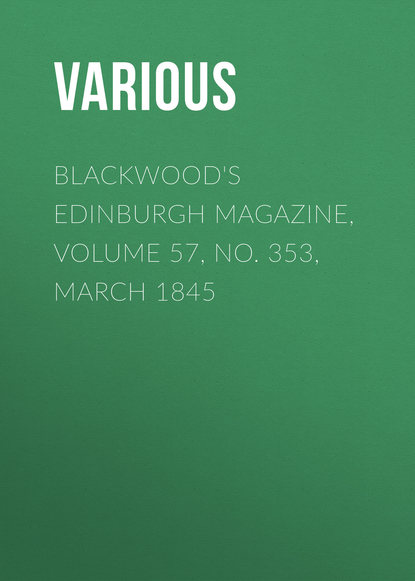По всем вопросам обращайтесь на: info@litportal.ru
(©) 2003-2024.
✖
Blackwood's Edinburgh Magazine, Volume 57, No. 353, March 1845
Автор
Год написания книги
2017
Настройки чтения
Размер шрифта
Высота строк
Поля
20
Mrs Damer describes this lady, to whose amiability and accomplishments she does ample justice, as "a sort of Turkish chanoinesse," who had renounced marriage in order to devote herself to her mother – a circumstance which, if correctly stated, would be almost unparalleled in the East. But Mrs Poole's silence would rather lead us to suppose that Mrs Damer was mistaken.
21
A belief precisely similar prevailed throughout Christendom, previous to the year 1260 of our own era: the reference being to the two mystic periods in the eleventh chapter of the Apocalypse.
22
An anecdote of this personage is given in Mr Lane's works, i. 153.
23
It is hareem etiquette to address mothers by the names of their children.
24
Marriages of slaves from the khalif's hareem occur more than once in the Thousand and One Nights.
25
The higher classes are not free from this reproach if we are to believe the story told by Mrs Damer, that Nezleh Hanum punished a female slave who had offended her by the daily amputation of a joint of one of her fingers!
26
A Spanish proverb of former days, defines "Castilian faith and Moorish works" as the ingredients of a good Christian.
27
Lectures on Agricultural Chemistry and Geology. 1 vol. 8vo.
Elements of Agricultural Chemistry and Geology. 4th Edition.
Catechism of Agricultural Chemistry and Geology. 7th Edition.
28
Elements of Agricultural Chemistry and Geology, 4th Edition, p. 239.
29
Yet we are sometimes led to doubt if our author be really so kind-hearted as he would have us to believe. The following passage, for example, would lead us to believe that he is really savage at heart, and that his humanity is little better than affectation. The contrast between the two passages which we have put in italics is very amusing. He is speaking of the weeding of pigeons.
"Every bird that is caught should be examined and recognized and every one exhibiting signs of old age should be destroyed, by pushing the joint of the thumb with force into the back of the head, and severing the cervical vertebræ, or applying the teeth for that purpose; but should these modes be disliked or impracticable, rather than torture the poor devoted animals by abortive attempts, let their heads be cut off at once by a sharp table-knife." – (Vol. ii. p. 253.)
30
Diaries and Correspondence of James Harris, First Earl of Malmesbury. Edited by his Grandson, the Third Earl, Vols. 3 and 4, London: 1844.
31
Barrancas are those immense clefts or ravines, some of them several thousand feet deep, which abound upon the plateau, or table-land, on which the city of Mexico stands.
32
Orizava – in Mexican, Citlatepetl, or the Star Mountain.
33
The Mexican wolf.
34
A proverbial expression amongst the Indians, signifying something inimical or prejudicial; the day of ill luck.
35
Bixa Orellana – a species of dye-wood. String is made out of the bark. The wood takes fire easily upon friction.
36
Infamous by birth. The children of whites and negroes, or whites and Indians, or Indians and negroes, were infames de derecho.
37
Guachinango is another name for Lépero. Pulque is the favourite drink of the Mexicans, made from the sap of the agave or aloe.
38
Beef, salted and dried.
39
Walpole's Memoirs of the Reign of George III. London: 1845. 2 vols.











